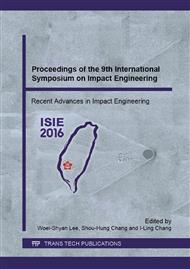p.133
p.139
p.147
p.153
p.159
p.167
p.174
p.180
p.186
Effect of Foam Structure on Impact Compressive Properties in Foamed Polyethylene Film
Abstract:
The purpose of this study is to elucidate the effect of foam structure on the impact compressive properties of foamed polyethylene film. Three types of foamed PE film were prepared, which have different foam structure: base type, spheral type and dense type. A quasi-static test was performed using a universal testing machine at the strain rate of 10-3~10-1s-1. Impact tests were carried out using a drop-weight testing machine at the strain rate of 101~102s-1 and using a split Hopkinson pressure bar method at the strain rate of approximately 103s-1. It was confirmed that the foamed PE film shows an increase of the flow stress with increasing of the strain rate, regardless of the specimen type. In the spheral type specimen, the elastic response is observed immediately after compression because the cell shape of this specimen has high bending resistance in comparison with the other two specimens. In addition, it is confirmed that the relative density and cell size affects the flow stress in the foamed PE film.
Info:
Periodical:
Pages:
159-164
Citation:
Online since:
September 2016
Authors:
Price:
Сopyright:
© 2016 Trans Tech Publications Ltd. All Rights Reserved
Share:
Citation:


